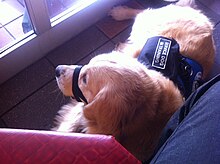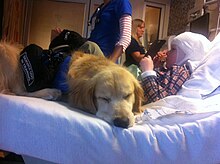Seizure response dog


A seizure response dog (SRD) (also known as seizure dog) is a dog demonstrating specific assisting behaviour during or immediately after a person's epileptic seizure or other seizure.[1][2] When reliably trained such dogs can serve as service dogs for people with epilepsy.[3]
Tasks
Tasks for seizure dogs may include, but are not limited to:[4][5][6][7]
- Find someone to help
- Activate an emergency response system
- Stimulate a person to help them "wake up" after a seizure
- Use body weight to keep the person in a specific position
- Act as a brace to help the person up
- Retrieve a phone or medication
- Physically remove the patient from an unsafe situation (e.g., the middle of a street)
Seizure alert dog
A dog demonstrating specific behaviour prior to a person's epileptic seizure is also referred to as seizure alert dog (SAD).[2][8][9] Reports suggest that some dogs can be trained to anticipate epileptic seizures.[3][8] However, this ability has been questioned.[10][11][12]
Seizure response and seizure alerting behaviour may spontaneously develop in dogs living with children and adults with epilepsy.[1][2][9]
Text is available under the CC BY-SA 4.0 license; additional terms may apply.
Images, videos and audio are available under their respective licenses.
